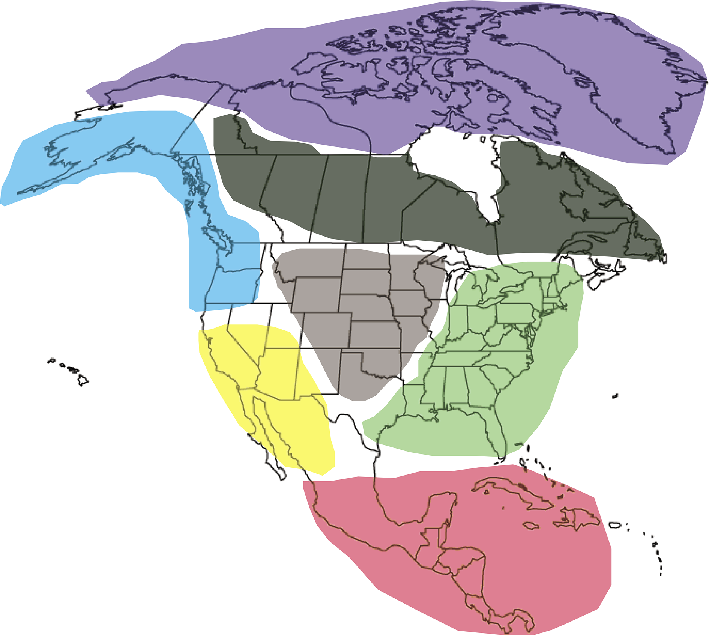- Home
- Publications
- PAGES Magazine
- A Novel Multiproxy Approach: The PAGES North America 2k Working Group
A novel multiproxy approach: The PAGES North America 2k working group
Nicholas McKay
Past Global Changes Magazine
22(2)
100
2014
Nicholas McKay
Fort Collins, USA, 23-26 June 2014
The North America 2k (NAM2k) Working Group recently met at the USGS Powell Center to begin Phase 2 of the NAM2k project in earnest. Phase 2 aims to build on the success of the first phase by expanding the scope of the project, both by including a more diverse and comprehensive array of paleoclimatic evidence for the past two millennia in North America, and by analyzing additional indicators and reconstructions of parameters beyond surface temperature, most notably, hydroclimate. Twenty working group members with expertise in tree rings, lake and marine sediments, corals, speleothems, boreholes, ice cores, glacial landforms, and climate modeling participated in the meeting.
The group reviewed the initial collection of data, and discussed best practices for extracting and combining paleoclimatic information from different natural archives, each with its own uncertainties and biases, and each with a different climate-signal filter. The group found that the initial PAGES 2k Phase 2 Data Selection Criteria were quite restrictive, and difficult or inappropriate to apply to some archives (e.g. boreholes and corals). Consequently, a more relaxed and nuanced approach was adopted. These criteria were reviewed by all PAGES 2k regional groups and have now been adopted network-wide (see: http://pastglobalchanges.org/ini/wg/2k-network/data).
The first and primary goal of the working group is to produce a clearly-formatted digital database of 2k-relevant proxy records for the continent that will facilitate a better understanding of climate variability in North America over the past 2,000 years. The deadline for assembling the next version of the database is the end of 2014. Subsequently, the group targeted three primary projects to be completed before the end of Phase 2 of the PAGES 2k project in 2016:
1) Subregional temperature reconstructions for North America
Based on the dominant airmasses, ecology, and the availability of proxy data throughout the continent, the group developed initial spatial targets for subcontinental temperature reconstructions (Fig. 1). Within each subregion, depending on data availability, we plan to produce (a) 2,000-yr-long multiproxy temperature index (time series) reconstructions, (b) 100-yr resolution pollen-based temperature reconstructions, and (c) borehole temperature reconstructions. These will be supplemented by a new tree-ring based temperature field reconstruction, which will utilize restandardized “signal free” tree-ring chronologies (Melvin and Briffa 2014).
2) Water isotope proxy synthesis
The group discussed how to take advantage of O and H isotopic composition observations in many archives. With interpretation based on generalized data models for each proxy system, archive and observation (Evans et al. 2013), the group will compile δ18O and δD records from across North America. By comparing both data models and observations, we hope to facilitate comparison and synthesis across records and archives. Because stable isotopes in meteoric waters represent source differences, the temperature path history of air masses, and mixing and precipitation processes, we hope this compilation will support the study of past changes in hydrology and atmospheric circulation, and comparison with the output of isotope-enabled earth system models (e.g. Schmidt et al. 2014).
3) Multiproxy investigation of extreme droughts and pluvials
Gridded, tree-ring-based paleohydrologic reconstructions for North America are well developed (Cook et al. 2004 and updates), and full, multiproxy integration of disparate archives and paleohydrologic parameters into a single reconstruction is beyond the timeline of phase 2 of the NAM2k project. Consequently, the working group decided to focus on multiproxy comparison during periods of particular interest during the past 2k, for which diverse evidence for hydrologic extremes is available. When possible, the group will compare geomorphic evidence and event records (e.g. shorelines) with multiproxy hydrologic, temperature and isotope data, using simple models of hydroclimatic processes (e.g. Graham et al. 2007) to better constrain the timing, amplitude and cause of the changes during these intervals of particular relevance.
The North America 2k working group is planning a brief gathering in San Francisco during the Fall Meeting of the American Geophysical Union this December. Anyone interested in contributing to the project is encouraged to join us. The time, date and location of the meeting will be distributed through the PAGES website. NAM2k is supported by both the USGS Powell Center and PAGES.
affiliations
School of Earth Sciences and Environmental Sustainability, Northern Arizona University, Flagstaff, USA
contact
Nicholas McKay: Nicholas.McKay nau.edu
nau.edu
references
Cook ER et al. (2004) Science 306: 1015-1018
Evans MN et al. (2013) Quat Sci Rev 76: 16-28
Graham NE et al. (2007) Holocene 17: 1197-1210

